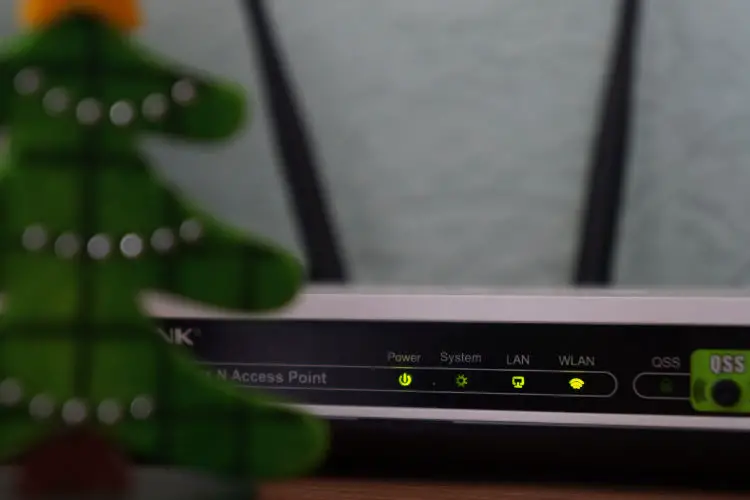Dead spots in your house can be incredibly frustrating whether you’re trying to work from home, stream your favorite movie on Netflix, or discover a new artist on Spotify. Old routers can play a big role in your frustration, so start by looking at the age of your equipment. But, even new routers can provide spotty coverage if they’re hidden away. So, if you’re looking for the best place to put your WiFi router in a two-story house or even a single-story home, here are some tips.
The best place to put your WiFi router for good reception, whether you live in a one or two-story house, is in a central location away from other electronic devices and reflective materials. Avoid hiding your router away in a remote corner for the best household coverage.
There are plenty of other factors to consider when finding the best location for your router as well. Mostly, it comes down to figuring out how to allow your router to send a signal to as much of your house as possible without obstructing it with thick walls and other materials that will absorb or reflect that signal.
Should you replace your Wi-Fi router?
Before we get into the details of where to place your router in your home, let’s talk about something glaring and obvious. If your router is really old, maybe even ten years or more, it’s probably time to upgrade.
It’s very possible to still be using a router that old. For instance, WiFi 4 was released in 2009. I know this from experience, as we had to replace a router nearly that old when we moved not too long ago.
While an old router might still “work” to some extent, there are some important things to think about. For instance, internet speeds have gotten much faster over the years, and you’ll need a newer wireless router to take advantage of that.
Security on modern routers has gotten better
Unfortunately, there’s no way to completely avoid malicious behavior from hackers and other bad people. Just as quickly as the good guys develop security to protect us, the bad guys learn how to break it. But, you can make it much harder for hackers to access your home network along with your personal data.
When you’re looking at routers, you’ll most likely see two kinds of encryption. There’s WPA, and then there’s WEP. WEP is an older technology that you’ll only find on really old routers these days. Or, to be more specific, only older routers will feature ONLY WEP.
You want to be using WPA, and more specifically, WPA2 if possible.
Here’s what the FTC says about home network encryption:
WPA2 is strongest; use it if you have a choice. It should protect you against most hackers. Some older routers use only WEP encryption, which likely won’t protect you from some common hacking programs. Consider buying a new router with WPA2 capability.
An honest inventory of your home network is a good starting point. And, there are some great deals out there on decent modern routers, so it doesn’t have to break the bank to upgrade.
WiFi technology is better on newer routers – especially for bigger homes
WiFi 5 is a big upgrade. Some individuals and small families might not see massive benefits immediately from switching to WiFi 5, but in some circumstances, it can be great.
If you’re still using WiFi 4, you might be missing out on some nice features if you’re a cord cutter who streams most of your family’s entertainment, you’re working from home, and just staying in touch with friends and family over the internet as well. This is especially true if you have several people using your bandwidth at the same time.
Here’s a very quick and simple explanation of the difference between WiFi 4 and 5.
WiFi 4 runs on a 2.4Ghz network and features generally slower wireless speeds than WiFi 5 which runs on either 5Ghz or both 2.4 and 5Ghz (dual band).
A 2.4Ghz network, while offering slower speeds, will give you greater distances. So, you can connect to your router from farther away, but you won’t get the WiFi 5 speeds.
Generally, you don’t need WiFi 5 speeds unless you’re doing something like…say…streaming content like a cord cutter might do. If you’re simply working online, checking email, etc…then connecting at WiFi 4 speeds should be perfectly fine.
The big benefits come when you combine the two networks in a big house with several people accessing the internet at the same time. If you can keep your streaming device or smart TV close to your router and connected to the 5Ghz network, you’ll get the benefit of lots of bandwidth, which equals fast speeds.
And if you connect your slower devices that don’t need to stream lots of content to your 2.4Ghz network, you’ll be able to roam greater distances and stay connected.
So, where is the best router placement in my house?
Now that you have a good idea of why a newer router may be a big help, let’s take a look at where you should be storing your device for the best coverage in your house.
Find a central location for the best overall signal strength
Think of a sphere. Imagine a bubble. Pretend your house is that bubble. Would you put a router at the very edge of the bubble, or would you put it smack in the middle? Unless you have a very small house with walls made of lush, cotton fabric, you’re going to want to find a central spot and do a bit of planning to get the best WiFi reception throughout your entire home.
This is even more important in a two-story house. For instance, you want to avoid placing your router on the bottom shelf of an entertainment center against a wall on the first floor of your multi-story house. Think of how the router’s signal will be traveling, and what it will need to go through to get to your upstairs bedroom.
Also consider what types of devices will need to connect to your router, and where they will be located. Remember, 2.4Ghz networks are slower, but travel farther while 5Ghz networks are super speedy but don’t travel as far.
Put your router higher up on a shelf if you can in order to get it away from the floor, or even mount it on a wall if that’s an option. Just make sure not to mount it in a corner. We’re looking for the closest spot to the center of the house that we can find.
As mentioned, try to avoid corners, even in large or main rooms, such as the living room. The more your router’s signal can travel unobstructed, the better your reception will be.
WiFi interference: metal objects and thick walls are not a WiFi signal’s friend
Understand what your router is throwing out into your world. When it’s connected and broadcasting, your router is emitting electromagnetic radio waves. There are certain materials that will interact with or interfere with those waves. Physical obstacles can wreak havoc with your wireless network. Let’s have a look.
Metal is a conductor, which means that it really likes those electromagnetic waves and wants to eat them up. If you place your router near a bunch of metal appliances, furniture, or almost anything, even a strong signal will be absorbed to some extent. You can minimize this by avoiding metal near your router as much as possible.
Brick walls, stone, concrete, plaster, and other natural materials like these will do the opposite. They will stop the wireless signals by reflecting them. This is one of the reasons that it can be difficult to get a strong WiFi signal, and internet connection, through the thick walls and floors of a well-built house. Locating your router in a central location can really help with this problem.
So, think of what each room in your house contains. For instance, kitchens might not be the best place to store your router. We normally find loads of metal appliances there, and it can be hard to find a convenient place out in the open for your router if you keep it in the kitchen.
Also, microwave ovens run at the same frequency as your 2.4Ghz network, which can cause even more interference. Personally, this one doesn’t bother me all that much since we don’t constantly run our microwave, and it’s really never bothered us…even when we’re popping popcorn for a streaming movie on Amazon Prime.
In general, try to avoid thick walls where you can. And, remember that metal, stone, and other materials can wreak havoc on your WiFi signal if you don’t plan well.
Other electronic devices may compete with your router
We often want to keep all of our electronic devices shoved into one corner behind a TV so we can get it out of sight. However, just like with the microwave, certain devices can compete with the electromagnetic signal that your router puts out.
If possible, don’t throw your router into the “pile of devices” that sits behind the TV. If your router has its own space, even just a bit of it, you’ll also provide more room to adjust the antennas on the router, which is crucial and what we’re talking about next.
Just remember, knowing where your sources of interference are will help you to avoid them!
Adjustable antennas: Fiddle with them until you get them right – or set it and forget it
This is a genuinely confusing topic. No one explains this to us when we get our driver’s licenses or our Costco cards, so how are we supposed to know? I’ll tell you.
Strangely, it has more to do with the antennas in two devices than just the ones on your router. A signal will connect better if both the sending and receiving antennas are in the same orientation, either horizontal or vertical. Do you know the orientation of each antenna in every one of your devices? I didn’t think so. Neither do I.
So, one option is to point one antenna straight up, vertically, and one of them straight out, horizontally. This will cover all of your bases. It may also give you better coverage throughout a multi-level house.
If your router only has one antenna, try an angle between 45 and 60 degrees. You may need to play with this setting for a while until you feel like you’re getting the best coverage for your home.
If your router doesn’t have an antenna at all, just make sure you are sitting it in the proper orientation. So, if the manufacturer says to keep it standing, keep it standing. If it should be laying flat, let it nap. Mnemonics!
Other quick tips
- Keep your router out of the direct sunlight
- Give your router as much airflow as possible
- Dust it off frequently, especially if you have pets
- Keep it somewhere safe where it won’t get anything spilled on it
- Compliment your router from time to time (who knows…might help?)
Best place for your home router – the final decision
Aside from magically suspending it in midair in the very center of your house, you’ll need to find the best compromise between centrally locating your router and not having it become an eyesore in the room.
Avoid thick walls, corners, and materials that will absorb or reflect the WiFi signal of your router. Give it some space of its own, and make sure its antennas are pointed happily. And remember, if it’s time to upgrade, go shopping!
If you have any comments or suggestions about where to place your router in your home, let us know in the comments.


